Archive for Garden Design
Planning and Maintaining a Shrubbery
Rock gardens and shrubberies might be the two best ways to add dimension to your landscaping efforts without breaking the bank or giving yourself more work down the road. Just like a rock garden, shrubberies are coming back in style!
Shrubberies are actually easy to maintain and take care of as well. Shrubs are technically woody plants that are far shorter than most trees yet have a network of stems that can really liven up a backyard or add a little privacy to your home’s front facade.
Flowering broom shrubs and rhododendrons even look beautiful in their own right and don’t need too much support from your annuals and perennials to enliven your home.
That said, a lush lawn never hurts, so if you need help in that department DK Landscaping is here to lend a helping hand. DK Landscaping can also help with irrigation.
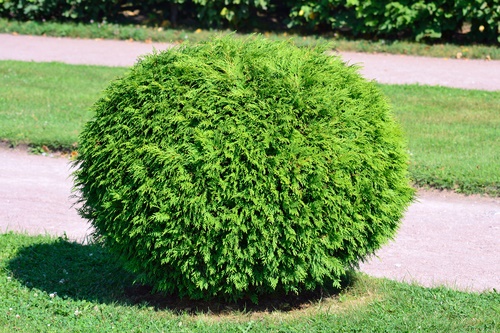
Planting a Shrubbery on Your Property
Shrubs are normally under ten feet in height and can either be evergreen or deciduous. This means that you can expect to find two classes of shrubs – one of which loses its leaves every autumn and then grows them back come springtime (deciduous) and the other kind of shrub retains its leaves on a year-round basis (evergreen).
- Leaving Room to Grow
Two other factors that you need to consider right off the bat is the maturity of the shrub that you’re interested in and, secondly, making sure that that shrub has enough room to grow without crowding out its neighbors.
The maturity and species of the shrub you go with will go a long way in determining how much space you need between each shrub and whether you’re letting in too much (or too little) sun to all of the shrubs you’ve planted as they go along in their growing cycle.
As an example, a shrub that’s much more bush-like and grows vertically like a arborvitae will require less sun, root space, and maintenance since it’s an evergreen and its stems don’t tend to blossom horizontally.
Bamboo palm or barberry, on the other hand, are actually quite low to the ground and need a little room to blossom out horizontally, so you’ll want to leave adequate space between each one and enough daylight so that the sun can reach down and nourish each individual shrub.
- Dig a Wide Hole
After you’ve picked out which shrub goes with the surrounding flowers and accessories in your yard, you need to transplant your shrubs and get them into the ground safely.
Digging a hole double the width of your shrub’s root ball is a good way to ensure that the roots get nourishment. After you’ve dug your hole then make sure to jostle the soil around slightly so that you’re not dealing with packed soil and your shrubs can continue to get nourishment.
- Transplanting the Shrub
When your hole is dug, carefully lower the shrub into place and put soil around the base. Then you’re going to want to spread out some mulch at the shrub’s base – just make sure that you go no more than six inches deep with your mulch.
- Regular Maintenance and Watering
Shrubs grow best in moist conditions that avoid too much saturation.
This means that regular watering from March to August in four-season climates should, in conjunction with some help from the sun and mother nature, provide most of the nourishment that your leucadendrons, rhododendrons, buckthorns and butterfly roses need to flourish.
An irrigation system is one of the best ways to prevent water waste and over-watering. For more on shrub maintenance and irrigation, contact DK Landscaping’s specialists today.
Building a Rock Garden: Everything You Wanted To Know
Rocks gardens, sometimes called alpine gardens and less commonly rockeries, are structures made from stones, rocks and boulders that you can build around your garden populated with perennials and annuals to really set it off.
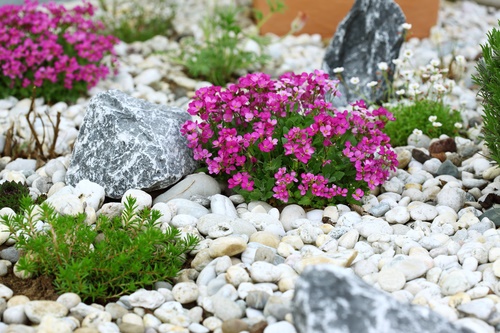
Rock Garden: What You Should Know
Usually rock gardens are role players or a kind of supporting cast for the main players that are your perennials, biennials and annuals.
The exception would be some Zen gardens in Japan that are designed almost exclusively from rocks, boulders and sand and designed to open the doors to enlightenment…but for now we’ll keep both feet squarely planted in the real world.
- Why Create a Rock Garden?
A lot of homeowners want to know right off the bat why they should be investing their time and energy into a rock garden in the first place.
That’s a great question and the answer really boils down to aesthetics and practicality. On the aesthetics point, rock gardens can lend a rugged air to your garden and make a very natural complement to your roses and annual flowers.
The other side of the coin is practicality: Rock gardens make a lot of sense if you’re working with an area that hards to reach with a lawnmower and provide regular maintenance to.
Many homeowners also consider putting up a rock garden to make a clearer demarcation line between an outdoor patio area, mulch and their garden proper. This really lends a lot of perspective by creating a more dynamic environment and allowing you to naturally get a wider color palette into your backyard.
- Where to Plant Rock Gardens?
You definitely want to select the right rocks and stones for the job when it comes to creating a rock garden that naturally allows you to find the optimal balance between earth tones and flowering brilliance.
For instance, if you have a lot of outdoor space in your backyard and a slight undulating up (or down) that might call for a staircase comprised of stone slabs or a tiny pebble walkway, then you could try something like this to lend more perspective and work with the existing elements.
You can even light the way with sconces along your pathway and combine stone slabs with more petite rocks forming your walking path. A few low maintenance yet vibrant perennials like dahlias and creeping thyme can work great running along the side too.
If you’re dealing with a really steep slope, then working in some larger rocks or complementing preexisting boulders can make a great retaining wall or framing device for a rock garden down below. A combination of flowers, shrubs and chips can set things off underneath.
You might also try erecting a rock garden near hard-to-reach areas running along a fence or hilly areas as these really are the perfect excuse for building up a rock garden and turning lemons into lemonade with your next outdoor project.
- Can I Still Go Zen?
You absolutely can still incorporate aspects of a traditional rock garden into your next backyard project!
The Zen Temple of Ryoanji means The Temple of the Dragon at Peace, and it’s easy to see how it got that name: Using open space to its advantage, Zen rock gardens are peaceful reposes and typically only call on a few rocks, pebbles and moss to achieve their tranquilizing effects.
To create your own Zen rock garden use edging stones, pebbles and prune your plants to fit the aesthetic you’re going for. For help getting there, contact us the gardening professionals.
Flower Bed Ideas – A Few Good Tips You Should Follow
Flower beds are one of the most convenient ways of sprucing up your outdoor decor and beautifying your entire yard.
Planting a flower bed is also a labor of love for millions of homeowners who already have the knack (and experience) for it; for those who don’t, the rest of this post if for you.
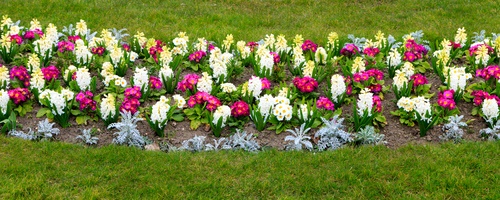
And if you’re still worried about your garden or you feel like your entire yard could benefit from aeration, then don’t hesitate to contact us your lawn experts. Now, let’s get started:
Tips for the Perfect Flower Bed
The perfect flower bed brings together form and function by applying a few simple tips in order to create a whole that’s greater than the sum of its parts.
- Focus on Framing
Part of the “form” part of creating the ideal flower bed for your home is going with a melange of perennials, annuals and shrubs for variety and framing.
In the same way that what’s in the background on a stage set can help to frame all the action going on in the foreground, you want a “framing device” in the back of your flower bed to draw your eye into the action.
A good rule of thumb is to plant tall perennial plants in the back of your garden to get the most out of everything going on upfront.
If you’re on a tight budget or you want to make a simpler landscaping project for yourself, then you can always put shrubs behind your perennials and annuals as well.
- Blend Perennials and Annuals
Annual flowers cycle through the germination, seeding, flowering and expiration process in one single year whereas perennials are able to grow from one year to the next with an off-season of dormancy in the winter.
The good news is that perennials like roses, daylilies, and peonies tend to play nice with annual flowers like marigolds and zinnias when it comes to finding the right balance between earth tones and more vibrant colors for your home garden.
- Combining Earth Tones and Vibrancy
In particular, the pink of a blossoming peony tends to work beautifully with the vibrant red of most roses. Marigolds and zinnias can also work well together if you’re looking to combine more tropical orange and yellow tones into your next flower bed.
Zinnias are actually easier to cultivate than most annuals and come in a myriad of colors that can make any garden really pop and dazzle guests.
You can find zinnias in purple, crimson, rose and scarlet to suit your tastes and make a flowing color combination with actual roses or even peonies when it comes time to get going.
Putting on the Finishing Touches
Once you know the kind of look that you’re going for and how to frame it with shrubs and/or tall perennials, then you want to move onto decorating fences or surrounding wall structures.
For this the beautiful pink and purples of an annual flower like the climbing snapdragon or greens, purples and yellows of passion flower can work very well.
Peony and roses upfront with climbing snapdragon or passion flower snaking along overhanging structures are an awesome want to frame your garden as well as beautify your home and complement your other landscaping efforts.
For help with aeration, irrigation, gardening or regular landscaping maintenance, or just to find out more tips like these, get in touch with DK Landscaping today.
Gardening Advice from a Landscape Maintenance Company
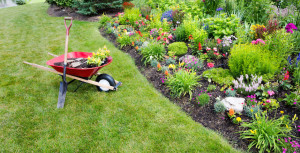 Most people expect three things from their landscape: for it to look good, for it to require little maintenance, and for that maintenance to be inexpensive.The reality is that to keep your garden looking green and healthy, you will have to invest a lot of time, money and effort. Serious gardening may not be easy if you have a busy life. However, with a little planning and the right advice, it is possible to reduce gardening costs while still having an aesthetically pleasing garden. In order to get the most out of your gardening time on the weekends, consider the following tips:
Most people expect three things from their landscape: for it to look good, for it to require little maintenance, and for that maintenance to be inexpensive.The reality is that to keep your garden looking green and healthy, you will have to invest a lot of time, money and effort. Serious gardening may not be easy if you have a busy life. However, with a little planning and the right advice, it is possible to reduce gardening costs while still having an aesthetically pleasing garden. In order to get the most out of your gardening time on the weekends, consider the following tips:
- Understand Your Garden
Before you decide to add anything new to your garden or to make any big changes, look at what is already there. Pay attention to the weather, as well as to the light and soil in your yard. Look at the types of plants that are thriving under the conditions present on your property. When you go shopping for new plants, look for ones that flourish under those same conditions. - Put in a Few Trees
Trees are an excellent addition to your property and can help to increase its value. Mature trees not only provide a degree of privacy for your home, they can provide protection for plants lower to the ground as well. Trees last for a long time and require relatively little maintenance. - Choose the Right Plants
If you are a busy person without much time for gardening, you may want to focus on low maintenance plants. It is important to remember that the meaning of a term like “low maintenance” can differ from person to person. Plants that are considered by others to need little maintenance may actually require more gardening time than you are able to invest. If you have limited time for gardening, consider hiring a professional to handle your landscape maintenance. With their help, you may be able to get plants that require more effort. - Take Out the Tough Weeds Prior to Planting
When you are putting in a new landscape, preparation makes all the difference. By carefully preparing the soil, you can substantially reduce the amount of time and effort that you spend gardening. Remove the top layer of sod in the location that you intend to use for your garden. Completely remove annual and perennial weeds from the area as well. Till the soil and let the sun dry out any remaining weeds. Give it a week before tilling again. - Choose Plants of the Right Size
Look at the tags on your plants to find out how large they will get. Avoid crowding your garden beds and pay attention to the plants’ growth tendencies rather than try to restrict them. - Pruning
Good gardening involves pruning your plants annually to maintain their health and to keep your garden looking neat.
Landscape and Garden Design Tips For New Homeowners
Landscape and garden design is top priority as you’re excited about your new home. You can’t wait to finish decorating and furnishing every space in your home, including your lawn and garden. However, when you first start considering what the perfect layout for your garden would be, the options and work involved can seem overwhelming. Fortunately, you can simplify the entire garden design process by understanding how it works. In order to get your landscape and garden design right, keep the following basic tips in mind:
Don’t Brainstorm Your Landscape and Garden Design Ideas in a Vacuum
One of the biggest mistakes you can make with garden design is to sit in an empty room and try to come up with ideas. Successfully designing a garden requires inspiration; for this, there is inspiration all around you. In particular, there are three sources that you should pull inspiration from:
Nature — Naturally beautiful landscapes allow you to see how garden life can flow on its own with the right setup
Professionals — Looking at beautifully laid out parks, checking out professionally landscaped homes, and consulting with a landscaper are all great sources for landscaping ideas
Your neighborhood — Walking around your area and adding features from your neighbors’ garden designs that you do like — and avoiding the features that you don’t like — can really help you develop your own design, especially since the homes in the area will have some similarities to your own
Think Function and Form for Your Design
You want to be able to enjoy your outdoor space as your own little garden oasis. For this, you need to consider both form and function (you can’t create a garden oasis feel without the right design, but you can’t enjoy your garden oasis if your design hasn’t left you with any room to relax in it).
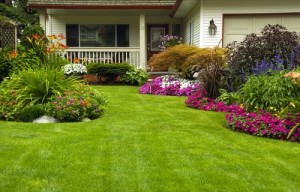
Create a Realistic Design Budget
Garden design budgets can vary drastically. If you approach your design haphazardly, you could find yourself turning your pockets inside out before the job is even half of the way done. On the other hand, you could end up missing on some outstanding garden design elements that you could easily afford if you approach the project cheaply with no real budget in mind. Avoid these types of issues by setting a realistic budget before you begin with your final plans. This way, you know what you can really afford to do. Also, because sudden expenses can occur, be sure to give your budget an extra 10%-20% emergency cushion.
Another issue to bear in mind is water savings and homeowners should set up a design that saves water and ultimately money. The state of California has laws in place in regards to water irrigation in order to protect and efficiently manage the county’s water supply.
Decide What You Can and Can’t Do On Your Own
Even if you have a green thumb, don’t simply assume that you can do it all. Installing certain fixtures, plants, etc into a garden the right way requires a team of professionals and the right equipment. Consult with a professional landscaper to discuss your options here.
Write Your Design Plans Down
Once you have all of your garden design plans in place, you need to make sure that you stick to them — and that you’re really going to like them. To this end, you should write everything down in two forms: prose and sketch. Writing everything you need down will keep your design plans in perspective with your budget and drawing a picture will give you a good depiction of how everything will actually look when you’re all done (the real thing doesn’t always match up with what’s in your head. If you can’t draw, then have a professional landscaper help you develop the image.
You’re Not Far From the Design of Your Dreams
Now that you know how to approach landscape and garden design, it’s time to get the process started. Reach out to us for a consultation as we’re here to help you get started.
Garden Design for Clay Soils
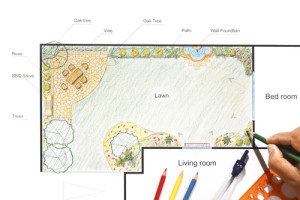 Clay soil is definitely an acquired taste for most gardeners, yet you might start swearing by clay soil once you hear some of the benefits listed below. First, though, what the heck is clay soil and how can it benefit your garden?
Clay soil is definitely an acquired taste for most gardeners, yet you might start swearing by clay soil once you hear some of the benefits listed below. First, though, what the heck is clay soil and how can it benefit your garden?
Clay Soil Vs. The Competition
Generally when you walk into a nursery, outdoors department or speak with a landscape maintenance company, you might be steered more towards silt soils or loam soils before clay. That’s because clay soil is composed of tiny plates or granules that can harden over time.
You’ve no doubt had the experience of plunking your shovel down into the ground, ready to get your garden going in the spring, and run up against clay. In spite of its hardness, though, clay soil is great for retaining moisture, nourishing your garden as well as retaining nutrients and fertilizers between individual clay particles.
Loam, relatedly, is a combination of clay, sand and silt and is very versatile, moldable and just easy for even inexperienced gardeners to work with.
Benefits of Clay
Part of the reason that loam soil is so moldable, to our main point, is that loam contains clay. The clay in the loam ensures that what you’re working with clumps into granules whereas the silt and clay components of loam help to retain moisture and nourish the plants in your garden.
Clay soil works wonderfully for annuals as well as perennial plants since the clay allows these plants to get a firm (and nourishing!) hold with their roots. The grip that perennials and annuals get with clay can withstand otherwise harsh humidity and temperature changes.
In short, clay’s fantastic as a garden design foundation since it provides a hearty root structure and allows plants to withstand harsh conditions. Moreover, you won’t need to water or fertilize as much with clay as with other soils. All good things.
Working with Clay Soil
Clay soil as a garden design foundation can accommodate a pretty wide range of shrubs, climbers, conifers and trees. Everything from popular conifers like ginkgo biloba and a deciduous evergreen like cotoneaster to rosa and fuchsia shrubs makes a great complement to clay soil.
To provide even more nutrients for these clay-compatible shrubs and conifers try adding a light mulch to your garden. Leafmold, composted bark and long manure work especially well with clay soil in terms of providing an easy-to-work-with mulch that does wonders for your plants.
Mulching Your Clay Foundation
When you actually get down to planting, mulching the plants up to three inches is a good idea for a few reasons.
Just a few inches down allows the right amount of moisture to hit your plants’ roots while tamping down weed growth and providing shielding from the elements.
One problem that people have with clay soil is that they sometimes overwater. Remember that clay soil retains water and moisture better than other garden foundations and, therefore, doesn’t need around-the-clock watering.
You’ll know that you’re doing too much watering when you notice a lot of the plants visibly retaining water and you notice globs of water on the clay surface the next day. These would both indicate that it’s time to cut back and let clay soil work its magic.
Creating the Perfect Garden
If you understand how clay’s small granules retain moisture and you know not to overwater, clay can offer a ton of benefits beyond more favored soil types.
You might consider planting eucalyptus trees, gorgeous flowering plants like bergenias and some of the conifers mentioned above for the perfect garden design. Contact Xeriscape today to get started.





